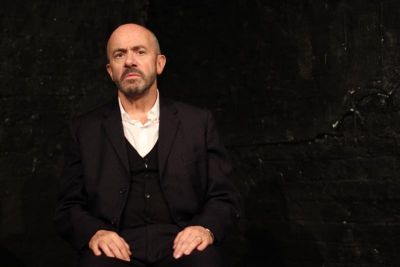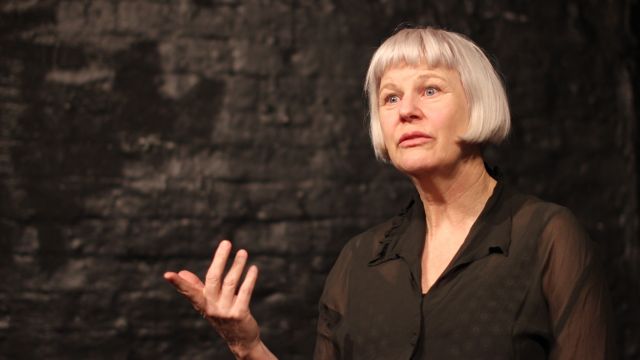L’Amante Anglaise
In 1949, parts of a dismembered female body were discovered on various trains that had all passed under a viaduct in rural France. All parts were found and the body reassembled - except the head. It seems that was never found. From this macabre event, Marguerite Duras built a fictional exploration of the inner life of those involved: the murderer, her husband and perhaps, on the most unreliable evidence, the victim herself.
Laurence Strangio’s production is a fine example of no tricks, no gimmicks and no hiding place theatre. There are no lighting changes, there is no sound design, and no set beyond two hardback chairs in a brightly lit, black painted space. There is no make-up and one minimal costume change. Two actors sit a few metres apart. But what we get is ‘pure’ theatre – and acting of the highest order from Jillian Murray and Rob Meldrum.
The text is not a ‘true crime’ voyeur’s trip, nor a police procedural, nor a detective story. At one point, an ‘interrogator’ says, ‘I’m not interested in the facts, but in what lies behind the facts’. There is something quintessentially French (if I may have a broad generalisation) about this, akin to why Agatha Christie’s mysteries have never been popular in France. Here, there is not only the feel of the small French village, where everyone knows and suspects everyone’s business, but also the feel of the interrogations that are carried out by Inspector Maigret in which history, feelings and motives are far more interesting than ‘the facts’. As for the facts, well, yes, she did it. So much for that.
In Part One, Ms Murray interrogates Pierre (Mr Meldrum), the husband. What is she? Not a cop, so… a psychologist? A sociologist, journalist, philosopher? We never know, but Ms Murray is calm, self-possessed, level and persistent. Mr Meldrum presents Pierre as a man who tries to pass himself off as an ordinary chap – le moyen sensual – embroiled in unfortunate circumstances that he claims not really to understand. Mr Meldrum controls the tone precisely – but lets us see behind it. As Pierre answers – or doesn’t – the interrogator’s questions in a supposedly objective, disinterested fashion, he shifts in his chair, covers his face, and holds his head. He is cold, matter of fact and so straightforward and cooperative that one can’t believe a word he says. In keeping with one’s ever shifting sense of reality or ‘truth’, one can almost believe that he is the murderer.
 In Part Two, Mr Meldrum becomes the interrogator and Ms Murray becomes Claire, the murderer. Ms Murray affects an astonishing transformation. Her lovely face ages as we watch; it becomes guarded and pinched and obtuse and joyous - inaccessibly joyous in a way that is entirely Claire’s own and cannot be shared. She does not weep, but her eyes fill with tears at her frustration and loneliness even while she is denying both. Here the interrogator is tougher. Claire, after all, killed her deaf and dumb, overweight cousin Marie in the cellar, dismembered the body and confessed to it in a café full of people. Now she will go to prison – she supposes. She seems almost indifferent. So where has she hidden the head? She won’t say. She won’t answer until she is asked the right question. And what is that? She says she doesn’t know. As for why…? Was she – is she – still in love with her policeman lover from when she was twenty-five and that love lost forever? Was she jealous of Marie’s relationship with Alfonso, the Portuguese handyman? Was it simply that Marie was so… silent and fat? All of the above? Was she impossibly lonely, happy only in the thoughts she could never express to anyone? We don’t know. We can’t know.
In Part Two, Mr Meldrum becomes the interrogator and Ms Murray becomes Claire, the murderer. Ms Murray affects an astonishing transformation. Her lovely face ages as we watch; it becomes guarded and pinched and obtuse and joyous - inaccessibly joyous in a way that is entirely Claire’s own and cannot be shared. She does not weep, but her eyes fill with tears at her frustration and loneliness even while she is denying both. Here the interrogator is tougher. Claire, after all, killed her deaf and dumb, overweight cousin Marie in the cellar, dismembered the body and confessed to it in a café full of people. Now she will go to prison – she supposes. She seems almost indifferent. So where has she hidden the head? She won’t say. She won’t answer until she is asked the right question. And what is that? She says she doesn’t know. As for why…? Was she – is she – still in love with her policeman lover from when she was twenty-five and that love lost forever? Was she jealous of Marie’s relationship with Alfonso, the Portuguese handyman? Was it simply that Marie was so… silent and fat? All of the above? Was she impossibly lonely, happy only in the thoughts she could never express to anyone? We don’t know. We can’t know.
Each time we think there is an ‘answer’, it slips away, or dissolves. Neither one of the ‘interrogators’, nor the audience, ever pins down with any certainty what lies behind the facts. The text is laden with perfectly chosen tiny details – the slant on the three doors at the bottom of the stairs, the black ‘English mint’ in the garden, a concrete bench, words written in coal on the cellar walls, greasy stews and firewood. Such realities anchor the characters to their quotidian setting, but only serve to heighten the finally inexplicable nature of their actions.
This is a revival of last year’s production, presented then, with the same cast, to mark Duras’ centenary as part of La Mama’s ‘Celebrating Women’ season. But Mr Strangio has also directed this same work twenty years ago with John Flaus and Brenda Palmer. Yet again, he displays here all the subtlety and attention to detail and nuance that the piece requires,
That these two actors can deliver a text that circles and returns, circles and returns with such unadorned clarity and controlled emotion is their great achievement. At the end Ms Murray and Mr Meldrum appear understandably exhausted. They endure our scrutiny and give all they have. They give us two characters I won’t forget, two characters from whom one can’t take one’s eyes as they fascinate in their implacably guarded interior beings.
Michael Brindley
Photographer: Oscar Strangio.
Subscribe to our E-Newsletter, buy our latest print edition or find a Performing Arts book at Book Nook.

